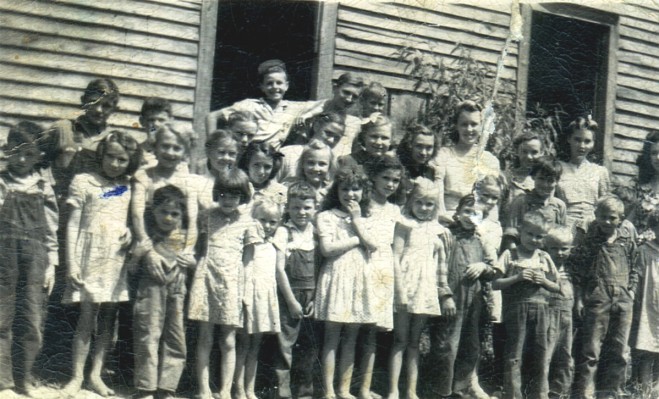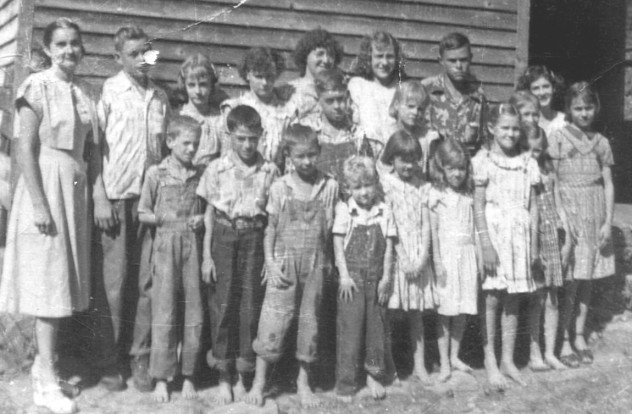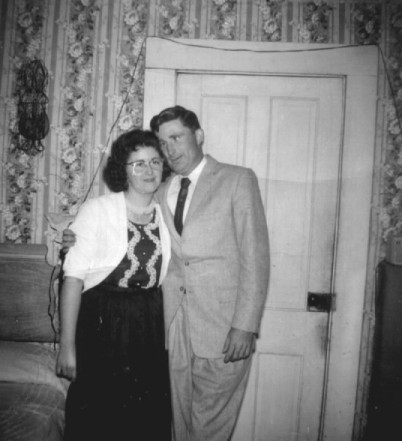|
After hearing Auda recite
this alphabet rhyme, I asked her where on earth she learned this. She
doesn’t really remember if it was while she was going to school in Johnson
Hollow or it could have been from her school days in Happy Hollow, one or
the other. I had never heard of either school before, so Auda shared some
of her memories of growing up in the area of Copeland Cove, where both of
these one-room schools were located in the late 1940s and early 1950s.
Auda was the daughter of Alex Hammock and Dora (Dishman) Hammock. Counting
Auda, there were nine children in her family whose names were Leslie,
Cordell, Clarence, Jessie, Marven, James, Minnie, and Velma.
|
|
The Johnson Hollow School Group |
|
The Happy Hollow School Group |
|
Auda remembers how the children in her family, after getting home from school each day, would carry in wood for the night during the winter months. Coal oil lamps were used since they had no electricity in their home. Butter and milk were kept in the spring since refrigerators were a luxury nobody had during those days. Forrest Ramsey had a “rolling store” in a little truck, and every Wednesday, he would drive up Copeland Cove selling most anything that was found in general merchandise stores in those days. Shirley Stockton also had a “rolling store”, and he would come by on Tuesdays. Mr. Stockton had a chicken coop on top of his truck, and live chickens could be bought or traded for. Children who were growing up then could buy candy, cookies, and chewing gum if they were lucky enough to have the money to buy these special treats. Pencils could be bought two for a nickel. Mrs. Edna Ward, who ran a second-hand clothing store in Livingston, would bag up clothes from her store and bring them out to the school in Johnson Hollow. The children would all push their seats together, and the bags of clothes would be dumped out on top of the seats. Their parents would go through the clothes and pick out what they wanted to buy for their families. This was done around the first Friday of each month, and was a day most everyone looked forward to. The kids in Auda’s family would take their lunch to school, and would get up every morning to fix what they would eat that day for lunch. Sometimes these lunches would include ‘tater cakes and homemade biscuits; lots of times, they would take an onion along, too. All this would be wrapped in paper to be carried to school. Most every child who went to these two schools had a glass to drink out of, which was kept at the back of the classroom. Water would be poured with a dipper from the water bucket into the glasses. If someone didn’t have a glass, a cup would be made out of notebook paper to be used to drink from. Cornbread and milk in jars would also be carried to school for lunch sometimes, and was kept in the spring near the school. One day a big rain came after the jars of milk and bread had been put in the spring and almost washed these lunches away, but not before McCoy McDonald and Oren Frank Huddleston came to the rescue and waded in to save the jars from the rising water. Some of the families who had children at Johnson Hollow School who Auda remembers were: Judge and Willie Ham-mock’s children whose names were Callie, Katie, Lassie, Benton Lee, and Clinton Ray Hammock; Walter and Fannie Allred’s daughter, Betty Allred; Coon and Mary Ann McDonald’s children whose names were McCoy, Marie, Joyce, Colleen, and Bobby; Mindy and Benny Phillips’ children whose names were Lela, Grady, Haskell, Lonzy, and J.B. Porter; Lily Carr’s daughter, Barbara; Aaron and Bessie Ferrill’s children, Gerald, Janie, Junior, Carl, Rex, and Sue; Earlin Dishman’s children whose names were Maxine, Jerlene, Betty, Lillard, and Carl; and Floyd Ledford’s children, Orbie, Emogene, Dean, Joyce, Patsy, and Carlon. Others who attended school there were Vella Mae Hammock; Margaret and Gerene Hill; Bobby Wisner; Cleveland Carr; and Ward, Robert, and Mary McCormick. The teachers Auda had at Johnson Hollow were Stella Huddleston Cantrell, Virginia Gunter White, and Herman Harris. Christmas was always a very special time at both of these schools. A Christmas tree would be cut about two weeks before Christmas, and decorations from popcorn and shelled corn would be made by the children. The children would draw names, and gifts would be brought to be exchanged. School programs were performed on the stage that was built across one end of the classroom. Each family would provide a sheet that would be used as curtains for the stage. The school room would be crowded with members of the students’ families who came to see the school programs that were held on the stage. Stella (Huddleston) Cantrell also taught at Happy Hollow, and some of the children Auda remembers attending that school include Jennings, Hattie Ruth, Joyce, and Gary Allred; Auda and James Hammock; Robert, Celia, and Louise Gore; Vada D. Brown; Irene, Elease, and Phyllis Hargis; Cleveland Carr; Junior Ledbetter; Jeannie Mae Cantrell, Claudine Cantrell; and Kenneth and Judy Brown. Both of these schools had baseball teams while Stella (Huddleston) Cantrell was teaching. Stella drove an old Jeep that provided transportation for trips to places such as Walnut Grove and Hardy’s Chapel to play ball. She had to make as many as three trips sometimes in order to get all the players to these places for a ballgame. After Johnson Hollow and Happy Hollow schools were closed, the children in this area attended school at Henard, which also ended up closing. School was then held at Pleasant Valley. Some of the teachers Auda remembers at Pleasant Valley are Claude Carr, Raymond Moody, and Glenn Masters. Singing is something Auda has always enjoyed doing. Along with her version of the ABC’s, were other songs I had never heard of, one of which she calls “Auda’s Little Song”. It goes like this: “Once I was a little boy living by myself, All the bread and cheese I had, I laid them on a shelf. Come a wing-wam-waddle to my Jack straw straddle, Come a wing-wam-waddle to my long way home. The rats and the mice, they lived such a life, I had to go to London to get me a wife. The road was so muddy and the streets was so narrow, I had to bring her home on an old wheel barrow. My wheel barrow broke, My wife got a fall, Away went the wheel barrow, Wife and all. Come a wing-wam-waddle, To my Jack straw straddle, Come a wing-wam-waddle, To my long way home.” Another one goes like this: “As I went around my whirley whickem whakem, I saw old John Jicken Jackem, I called Old Tom Tickem Tackem, To run old John Jicken Jackem Out of my whirley whickem whakem.” One she calls “Just Remember This” says: “Long may you live, Long may you tarry, Court who you please, But be careful who you marry.”
|


